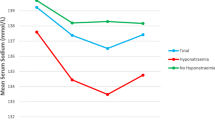Abstract
In this study, we report the prevalence and aetiology of hyponatraemia after surgery for hip fracture. We conducted a retrospective analysis of 144 consecutive patients who underwent surgery after sustaining a hip fracture. Data were collected from medical case records, operative notes and electrolyte results. Univariate and logistic regression analysis was conducted in order to identify significant independent risk factors for the development of hyponatraemia. Mild hyponatraemia was relatively common affecting 19 % (28/144) of patients pre-operatively and 28 % (40/144) post-operatively. However, moderate/severe hyponatraemia (plasma sodium concentration <130 mmol/l) was uncommon, affecting 1 % (2/144) of patients at the time of admission and 6 % (9/144) of patients post-operatively. Univariate analysis identified: female gender, pre-operative hyponatraemia, hypotonic fluid administration and thiazide diuretic use as being associated with the development of post-operative hyponatraemia. Age had no statistically significant association. Logistic regression analysis identified female gender, pre-operative hyponatraemia and hypotonic fluid administration being significant, independent risk factors for the development of hyponatraemia. Age and thiazide diuretics both had positive risk associations; however, these were not statistically significant. Mild hyponatraemia is a common finding in hip fracture patients; however, more severe cases are relatively rare. Pre-operative hyponatraemia and hypotonic fluid administration were the only modifiable risk factors identified.

Similar content being viewed by others
References
Bagshaw SM, Townsend DR, McDermid RC (2009) Disorders of sodium and water balance in hospitalized patients. Can J Anaesth 56(2):151–167
Anderson RJ (1986) Hospital acquired hyponatraemia. Kidney Int 29:1237–1247
Arieff AI (1986) Hyponatraemia, convulsions, respiratory arrest, and permanent brain damage after elective surgery in healthy women. N Engl J Med 314:1529–1535
Klein L, O’Connor CM, Leimberger JD, Gattis-Stough W, Pina IL, Felker GM et al (2005) Lower serum sodium is associated with increased short-term mortality in hospitalized patients with worsening heart failure: results from the outcomes of a prospective trial of intravenous milrinone for exacerbations of chronic heart failure (OPTIME-CHF) study. Circulation 111:2454–2460
Lane N, Allen K (1999) Hyponatraemia after orthopaedic surgery. BMJ 318(7195):1363–1364
Harrington P (1999) Hyponatraemia after orthopaedic surgery. General journals must not alienate particular specialties. BMJ 319(7208):514
Hoffbrand B (1999) Hyponatraemia after orthopaedic surgery. Hypotonic solutions should be used infrequently. BMJ 319(7208):515–516
Marino A, Krikler S, Blakemore M (1999) Hyponatraemia after orthopaedic surgery. Rigorous audit and introduction of guidelines decreased hospital's figures. BMJ 319(7208):515
Mojiminiyi OA (1999) Hyponatraemia after orthopaedic surgery. Laboratory must play a part in patients' management. BMJ 319(7208):515
Severn AM, Dodds C (1999) Hyponatraemia after orthopaedic surgery. Failsafe system is needed. BMJ 319(7208):514
McPherson E, Dunsmuir RA (2002) Hyponatraemia in hip fracture patients. Scott Med J 47(5):115–116
Tambe AA, Hill R, Livesley PJ (2003) Post-operative hyponatraemia in orthopaedic injury. Injury 34(4):253–255
Wald R, Jaber BL, Price LL, Upahyay A, Madias NE (2010) Impact of hospital associated hyponatraemia on selected outcomes. Arch Intern Med 170(3):294–302
Hagino T, Ochiai S, Watanabe Y, Senga S, Saito M, Takayama Y, Wako M, Ando T, Sata E, Haro H (2013) Hyponatraemia at admission is associated with in hospital death in patients with hip fracture. Arch Orthop Trauma Surg 133:507–511
Sah A (2014) Hyponatraemia after primary hip and knee arthroplasty: incidence and associated risk factors. Am J Orthop 43(4):E69–E73
Reynolds RM, Padfield PL, Seckl JR (2006) Disorders of sodium balance. BMJ 332(7543):702–705
Powell-Tuck J, Gosling P, Lobo DN, Allison SP, Carlson GL, Gore M, et al (2008) British Consensus Guidelines on Intravenous Fluid Therapy for Adult Surgical Patients—GIFTASUP. Available from: http://www.ics.ac.uk/downloads/2008112340_GIFTASUP%20FINAL_31-10-08.pdf (Accessed 04th Oct 20011)
Wakil A, Ng JM, Atkin SL (2011) Investigating hyponatraemia. BMJ 342:d1118
Ethical statement
All procedures performed in studies involving human participants were in accordance with the ethical standards of the institutional and/or national research committee and with the 1964 Helsinki Declaration and its later amendments or comparable ethical standards. For this type of study, formal consent is not required.
Conflict of interest
The authors declare that they have no conflict of interest.
Author information
Authors and Affiliations
Corresponding author
Rights and permissions
About this article
Cite this article
Grant, S.J., Winter, A., McGlynn, J. et al. Aetiology of hyponatraemia after hip fracture. Eur Orthop Traumatol 6, 163–168 (2015). https://doi.org/10.1007/s12570-015-0303-5
Received:
Accepted:
Published:
Issue Date:
DOI: https://doi.org/10.1007/s12570-015-0303-5



